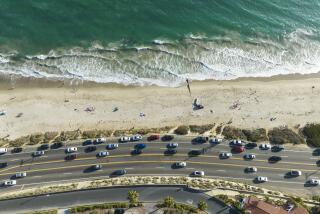Suspicious New Sheen Shows Up in Spill Zone
- Share via
Rushing rainwater Saturday wiped out earthen dams protecting fragile coastal wetlands from the oil spill off Huntington Beach, but environmentalists said the storm might help scrub the shore of contamination.
The Coast Guard, meanwhile, reported seeing a new and different-looking sheen of oil on Bolsa Chica State Beach in Huntington Beach, raising suspicions that there was a new source of leakage. Samples of the oil were promptly sent to the Coast Guard’s oil identification laboratory in Groton, Conn., for testing to determine whether it matched the crude spilled 11 days ago by a tanker mooring offshore near Huntington Beach.
Because the oil spilled from the tanker had been drifting southward, officials were concerned to see the sheen on the north end of Huntington Beach.
Coast Guard Petty Officer Elizabeth Neely said the sheen was spotted by Coast Guard pilots flying over the spill area throughout the day. Later, officials and workers on the ground also noticed it.
“The consistency of this oil doesn’t look the same and . . . the rest of the oil (from the tanker) seems to have drifted in a southerly direction,” Neely said. “It raised enough suspicion that someone thought they should take a sample to see if it was from the same spill.”
Saturday’s violent winds and the cold, piercing rain played havoc with cleanup efforts, pushing a protective containment boom out to sea and sending workers in yellow slickers scurrying for cover.
The storm washed away three temporary earthen dams that had been keeping oil-contaminated water from sensitive wetlands near the mouth of the Santa Ana River. And skimmers working off the coast to scoop up the remaining oil in the ocean halted their efforts because of the choppy seas, the Coast Guard said.
But while the weather made work more uncomfortable for the most part, officials said it did not reverse progress made in getting the oil off the beaches and out of the ocean.
A boom protecting Newport Harbor, blown away by the storm, was not replaced when officials determined that a second boom--which withstood the winds--was sufficient.
And environmentalists said it was good news that the sand berms at the mouth of the Santa Ana River washed away, because the rainwater washing out to sea would scrub out small amounts of oil that had leaked into marshlands.
For more than a week, environmentalists and flood control officials had weighed the consequences of damming up the channels. While the aim of the dams was to keep contaminated water from flowing into sensitive, newly restored marshland, they could also cause flooding in a storm if waters from the swollen river and channels were not allowed to flow out to sea.
On Saturday, as the raging waters of the river overwhelmed the dams, sweeping debris and even some oil that had leaked in back out into the ocean, environmentalists said they thought the dams had done their job in protecting the wetlands.
“There was a lot of crude oil retained here and now that has washed out to sea,” said Gordon Smith, director of the Huntington Beach Wetlands Conservancy. “Hopefully, there isn’t any more oil out at sea that will come back.”
The spill on Feb. 7, which occurred when an anchor pierced the hull of the tanker American Trader, dumped 394,000 gallons of oil into the water. Since then, the oil has been washing ashore along nearly 20 miles of Orange County’s coastline.
Sam Sacco, a spokesman for British Petroleum, owner of the oil aboard the tanker, said cleanup is in the final stages. Only 470 workers were patrolling the beaches on Saturday, down from 635 on Friday. Of those, 200 were working north of the Santa Ana River, mostly near the Huntington Beach Municipal Pier, with 270 others between the Santa Ana River and Laguna Beach, including 40 south of Newport Beach’s Balboa Pier.
“You’re not going to see 1,400 people on the beach anymore. You’ll see crews along the lines of 300 to 400,” Sacco said.
On Saturday, the number of live birds found covered with oil had increased by 26, bringing the total to 410. Another 51 were found dead, bringing that total to 275.
Officials at the bird rescue center in Huntington Beach announced that instead of training more volunteers to walk the beaches looking for birds, they have set up a 24-hour hot line for people to call if they find an oil-covered bird. Center personnel then will pick it up. The number is (714) 536-0202.
Staff writers Chris Woodyard and Shelby Grad and correspondents Tom McQueeney and Greg Hernandez contributed to this story.
More to Read
Sign up for Essential California
The most important California stories and recommendations in your inbox every morning.
You may occasionally receive promotional content from the Los Angeles Times.













